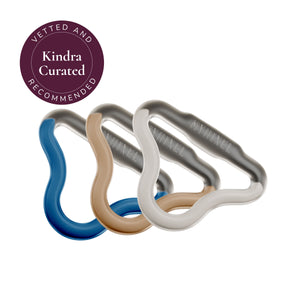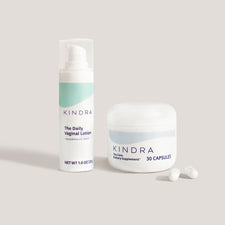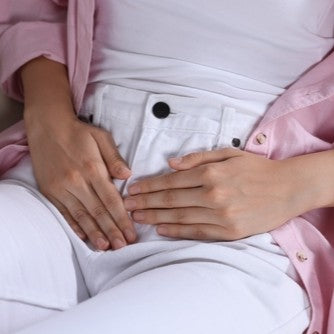If you’ve had a headache in the last few months, you’re not alone. An estimated 95 percent of women get at least one headache a year, and according to the Centers for Disease Control and Prevention (CDC), we’re twice as likely as men to report having severe headaches or migraines.
Headaches can happen to anyone at any age, but did you know that they can actually get worse during perimenopause and menopause? Here’s the rundown on why menopause headaches happen, the different types of headaches you can get, and how to deal with them.
Does Menopause Cause Headaches?
Yes, you can experience more headaches during the menopause transition. But there isn’t one specific thing to blame, but rather a whole host of potential causes.
One likely culprit: Hormones. (Surprise, surprise.) Fluctuations in sex hormones, especially estrogen, can trigger headaches in women. During perimenopause –– the period of time leading up to menopause –– your ovaries gradually produce less estrogen. This dip in your hormone levels can trigger hair loss, increased heart rate, hot flashes, and drum roll, please…headaches.
This isn’t just a menopause thing, either. Hormone levels naturally ebb and flow throughout the menstrual cycle each month, which can trigger headaches in pubescent girls and women. (Pregnancy and breastfeeding, which also involve significant hormonal changes, can also trigger headaches.) But a 2016 study published in the journal Headache found that women prone to migraines in the perimenopause state had a higher frequency of headaches when compared to those who were not going through menopause. This means that people are experiencing headaches at a higher frequency going from perimenopause to menopause.
Headaches can also be triggered by lifestyle factors such as stress, diet changes, exercise, sexual activity, and the environment. Unfortunately, some of these factors are inherently more common during menopause. For example, up to 56 percent of women in perimenopause report trouble sleeping, which is itself a risk factor for headaches.
Types of Headaches Experienced During Menopause
Menopause can stir up several types of headaches, including:
Migraines
Migraines — a severe type of headache that causes intense pain, light and sound sensitivity, and nausea or vomiting — affects an estimated 10 to 29 percent of women during the menopause transition. There are two types of migraines: migraines with aura (which cause temporary vision changes like light flashes or blind spots before the migraine strikes) and migraines without aura (which don’t come with those visual warning signs).
Migraines can be triggered by dips in estrogen levels, which may explain why they’re much more prevalent in women than men. And as mentioned earlier, your hormones are going haywire during perimenopause as your ovaries start to slow down production of estrogen. This may cause migraines or make them more frequent, especially if you’re already prone to them. Some research also suggests that migraines and other headaches can worsen for postmenopausal women who are on hormone replacement therapy (HRT).
Tension headaches
Tension headaches, which cause a tight-band-around-your-head feeling, are also common during the menopause transition. Experts aren’t exactly sure what specifically causes tension headaches, but they can be triggered by stress. More research needs to be conducted to understand the relationship between stress and tension headaches — and why tension headaches can happen during menopause, for that matter. However, it stands to reason that during a time of elevated stress and sleep disturbances (ahem, menopause), you might be more vulnerable to tension headaches.
Cluster headaches
Cluster headaches strike in a cluster, meaning that you get up to eight extremely painful headaches in a row every day for a few weeks or months before they temporarily disappear. They’re less common than migraines or tension headaches. Experts aren’t sure what causes cluster headaches. A small study found that 24 percent of women experienced cluster headaches during or after menopause, but the why isn’t totally clear, either.
Sinus headaches
Sinus headaches are headaches caused by sinus infections and mainly affect the areas around your eyes, cheeks, and forehead. (Allergies may also cause sinus headaches.) Common symptoms include pressure around your cheeks, a stuffy nose, and an achy sensation in your upper teeth. It also comes with a fever and discolored nasal mucus. True sinus headaches are pretty rare. People often assume they have sinus headaches when they actually are having a migraine with nasal symptoms.
Unfortunately, the relationship between sinus headaches and menopause is not well understood. You might be more prone to sinus headaches, however, if you already deal with migraines or other kinds of headaches.
Hypnic Headaches
Hypnic headaches are a rare headache disorder that only happens when you’re asleep. It predominantly affects post-menopausal women and lasts between 15 minutes and four hours. It’s known as the “alarm clock headache” because it typically wakes a person up from sleep. They most commonly occur in people over age 50 (aka post-menopause) but experts aren’t exactly sure what causes them or why they’re so common in older adults.
Related Symptoms
People can also experience the following related menopause symptoms simultaneously to their headaches:
- Hot flashes. People who experience hot flashes experience an intense warmth over their chest, neck, and face and profuse sweating. Preliminary research from the North American Menopause Society suggests that women with a history of migraines have worse menopause symptoms, including very severe hot flashes, than women who had never had migraines.
- Night sweats. During menopause, people experience night sweats and usually wake up to clothes or bedding drenched in sweat. The sleep disturbances triggered by night sweats and hot flashes may contribute to tension headaches or other types of headaches.
- Anxiety. Symptoms of anxiety like tension and panic are common during perimenopause. Anxiety and headaches, especially migraines, often go hand-in-hand.
Remedies for Menopause Headaches
For some people, headaches will get better after menopause. But for others, headaches will persist or worsen. (Sorry about that!) Either way, you shouldn’t have to just suffer from your headaches, especially if they significantly disrupt your life. Treatment will depend on the type you have.
For hypnic headaches:
- Try caffeine. According to the American Migraine Foundation, drinking caffeine at bedtime can often help treat hypnic headaches (and doesn’t affect a person’s ability to sleep). Forty to 60 milligrams (the equivalent of one black tea) is usually enough to do the trick, but talk to your doctor for more specific guidance.
- Talk to your doctor about medications. Prescription medications may help. A doctor might prescribe lithium, a mood-stabilizing medication used to treat bipolar disorder, or Indocin, a nonsteroidal anti-inflammatory drug often used to treat rheumatoid arthritis.
For migraines, tension, and sinus headaches:
- Manage your stress levels. Easier said than done, we know! However, there are some activities that you can do daily to address this headache trigger. (Less stress also means better sleep, so you can kill two headache triggers with one stone.) Try meditating, conducting controlled-breathing exercises, yoga, journaling, or other calming activities that reduce stress and anxiety.
-
Work on your sleep habits. Another one that’s easier said than done. But addressing the things that make it hard for you to fall or stay asleep can help you with your headaches (and just make your life better). Some places to start: Try some sleep-enhancing foods, invest in blackout curtains, and banish screens and phones from the bedroom. We also swear by our Core Supplement, which uses Ashwagandha and Pycnogenol to help you unwind and relieve night sweats.
- Avoid other headache triggers. This can come with some trial and error, since it depends on the person and the headache type. But if you notice that you always get migraines after happy hour with your friends, for example, it might be worth cutting back on how much alcohol you drink. (Sorry!)
- Exercise regularly. While exercise isn’t proven to reduce all menopausal symptoms, exercise can be a way to relieve stress, which can lower your risk of headaches. Try aerobic exercise or yoga, which have been shown to help with headaches, or any other type of movement you love.
- Try acupuncture. Research shows that acupuncture can help make migraines less frequent. It might also help relieve other menopause symptoms like hot flashes.
- Don’t forget OTC treatments. The pain reliever acetaminophen, which works by turning off pain receptors, can help fight headaches in the moment. Depending on the type of headache you have, you might need other treatment. True sinus headaches, for example, might require a trip to the doctor to fight the underlying infection.
For cluster headaches:
- Talk to your doctor for treatment. Cluster headaches can’t be cured but there are things a healthcare practitioner can prescribe to help you in the moment and to lessen the severity of your attacks. You might be given an injectable migraine medication to use in the moment, for example, or corticosteroids or lithium to help prevent or minimize future headache attacks.
You should also seek immediate medical attention if your headaches come with any of the following, more serious symptoms:
- Fever
- Convulsions
- Confusion or loss of consciousness
- Pain in the eye or ear
- New headaches that won’t let up (especially if you’ve never had headaches before)
- Sudden pain that feels like a blow to the head
- Consistently affects your day-to-day life
Conclusion
Menopause-related headaches can be an extremely painful and uncomfortable experience. While most headaches improve on their own, some may need to be managed using medications, exercise, stress-relieving practices, or a combination of the aforementioned remedies. If you’re experiencing persistent pain, talk to your healthcare provider to explore a treatment that works for you and your body.
Sources:
- Al-Hassany, L. et. al., Frontiers in Neurology, Giving Researchers a Headache — Sex and Gender Differences in Migraine, October 2020.
- American Migraine Foundation, Hypnic Headache, January 2017.
- American Migraine Foundation, Is It Migraine or Sinus Headache, June 2021.
- Anxiety and Depression Association of America, Headaches, Undated.
- Baker, F. et. al., Nature and Science of Sleep, Sleep problems during the menopausal transition: prevalence, impact, and management challenges, February 2018.
- Centers for Disease Control and Prevention, QuickStats: Percentage* of Adults Who Had a Severe Headache or Migraine in the Past 3 Months, by Sex and Age Group — National Health Interview Survey, United States, 2018, March 2020.
- Cleveland Clinic, Cluster Headaches, February 2021.
- Cleveland Clinic, Sinus Headaches, August 2020.
- Harvard Health, What type of headache do you have?, August 2020.
- Johns Hopkins Medicine, Headaches and Women: What Do Hormones Have to Do With It?, Undated.
- Johns Hopkins Medicine, Perimenopause, Undated.
- Journal of Family Medicine and Primary Care, Investigation of the role of herbal medicine, acupressure, and acupuncture in the menopausal symptoms: An evidence-based systemic review study, June 2020.
- Lauritsen, C. et. al., Headache, Current Treatment Options: Headache Related to Menopause — Diagnosis and Management, March 2018.
- Linde, K. et. al., Cochrane Database of Systematic Reviews, Acupuncture for the prevention of episodic migraine, June 2016.
- Martin, V, et. al., Headache, Perimenopause and Menopause Are Associated With High Frequency Headache in Women With Migraine: Results of the American Migraine Prevalence and Prevention Study, February 2016.
- Mayo Clinic, Fitness, September 2021.
- Mayo Clinic, Headaches and hormones: What’s the connection?, December 2020.
- Mayo Clinic, Migraine, July 2021.
- Mayo Clinic, Migraine with aura, July 2021.
- Mayo Clinic, Stress management, March 2021.
- Mayo Clinic, Tension headaches, September 2021.
- National Library of Medicine, StatPearls, Hypnic Headache, January 2022.
- North American Menopause Society, Can a History of Migraines Lead to More Severe Hot Flashes for Postmenopausal Women?, September 2021.
- North American Menopause Society, Depression, Mood Swings, Anxiety, Undated.
- North American Menopause Society, Headaches, Undated.
- Ripa, P. et. al., International Journal of Women’s Health, Migraine in menopausal women: a systematic review, August 2015.
- Sleep Foundation, Hypnic Headaches, April 2022.
- The Migraine Trust, Migraine without aura, Undated.
- Van Vliet, J. et. al., Journal of Neurology, Neurosurgery & Psychiatry, Cluster headache in women: relation with menstruation, use of oral contraceptives, pregnancy, and menopause, January 2006.













